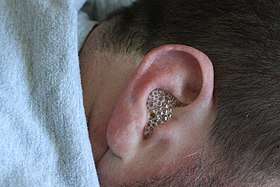Cerumenolytic
A cerumenolytic is an ear wax (cerumen) softening agent. Common cerumenolytics such as hydrogen peroxide and hydrogen peroxide - urea are topical preparations used to facilitate the removal of ear wax. Their side effects tend to be mild, including ear discomfort, transient loss of hearing, dizziness, and local irritation.
| Cerumenolytic | |
|---|---|
| Drug class | |
 Hydrogen peroxide, a common cerumenolytic, bubbles after being administered into a person's ear. | |
| In Wikidata |
Medical uses
Cerumenolytics are used to soften and break up ear wax. Using a cerumenolytic can reduce the need for flushing the ear with irrigants for wax removal. Additionally, cerumenolytics can also facilitate the manual removal of ear wax.[1] Overall, all cerumenolytics are considered to be equivalent in efficacy.[2] Cerumenolytics are administered directly into the ear, which is a form of topical administration that can be specified as "ototopical."[3][4] Generally, the use of a cerumenolytic involves instilling several drops of the product into the affected ear once or twice daily for a treatment duration of 3 to 5 days.[1][4] Each instillation is relatively quick (less than 5 minutes) and can be done either at home or in a clinical setting. However, like all ear wax treatments, the ear wax can reaccumulate in the ear after treatment, necessitating further treatment.[1] Cerumenolytics are not recommended in children less than 3 years-old.[1]
Available forms and classification
Cerumenolytics are available as topical preparations intended for installation into the ear.[1] Cerumenolytics can be classified based upon the formulation of their constituents: water based, oil based, or neither.[1]
| Classification | Product/preparation | Active chemical constituents |
|---|---|---|
| Water based |
|
|
| Oil based |
|
|
| Neither |
|
|

Contraindications
Cerumenolytics should not be used in ears that in which the ear drum has been perforated or is otherwise nonintact.[1] Cerumenolytics should also be avoided in ears that are actively infected due to the lack of research in this area (i.e. people suffering from otitis externa, a type of ear infection).[1]
Adverse effects
In general, cerumenolytics can cause ear discomfort, transient loss of hearing, dizziness, and local irritation.[1] Local reactions are least frequent with cerumenolytics that lack organic chemicals, such as a saline.[1]
Overdose
Using the cerumenolytic hydrogen peroxide as an example, no adverse effects are expected with overdose of an otic administered preparation.[5] The average middle ear volume is 0.4 mL, which limits otic accumulation in overdose.[6] It is unlikely that an cerumenolytic administered into the ear would cause systemic toxicity in an overdose situation, due to the lack of systemic absorption resulting from minimal volume flow within the inner ear.[7] However, again using hydrogen peroxide as an example, clinically relevant overdoses of cerumenolytics are possible if the drugs are administered by other routes (e.g. by mouth).[8]
Pharmacology
The mechanism of action of cerumenolytics vary by the classification.[1] Water-based cerumenolytics, including water itself, work by hydrating ear wax, fragmenting corneocytes (a type of skin cell) within the ear wax itself.[1] Cerumenolytics with peroxides release oxygen upon contact with the skin, inducing effervescence (bubbling) that mechanically fragments ear wax.[9] Oil-based cerumenolytics provide lubrication to the ear wax, softening the surface without fragmenting the ear wax. The mechanism of action of non-water- and non-oil-based cerumenolytics is unknown.[1] Using carbamide peroxide as an example, the pharmacokinetics of cerumenolytics are not well studied.[10]
Veterinary use
Cerumenolytics are used to treat cerumen impaction in cats and dogs.[11] The removal of cerumen is also an important step in the treatment of otitis in small animals.[12] Veterinary cerumenolytics possess different potencies. Diocytl sodium sulfosuccinate (DOSS), dioctyl calcium sulfosuccinate, and urea or carbamide peroxide are considered to be potent veterinary cerumenolytics.[12]
References
- Schwartz SR, Magit AE, Rosenfeld RM, Ballachanda BB, Hackell JM, Krouse HJ, Lawlor CM, Lin K, Parham K, Stutz DR, Walsh S, Woodson EA, Yanagisawa K, Cunningham ER (January 2017). "Clinical Practice Guideline (Update): Earwax (Cerumen Impaction)". Otolaryngology–Head and Neck Surgery. 156 (1_suppl): S1–S29. doi:10.1177/0194599816671491. PMID 28045591.
- Petersen-Smith, Ann M. (2017). "30, Ear Disorders". In Burns, Catherine; Dunn, Ardys; Brady, Margaret A.; Barber Starr, Nancy; Blosser, Catherine G.; Garzon Maaks, Dawn Lee (eds.). Pediatric Primary Care (6th ed.). USA: Elsevier. p. 741. ISBN 978-0-323-24338-4.
- "ototopical – definition – English". Glosbe. Glosbe. Retrieved 2 April 2018.
- "How to Use Ear Drops Properly". Safe Medications. American Society of Health-System Pharmacists. Retrieved 24 March 2018.
- "Otex Ear Drops – Summary of Product Characteristics (SmPC) – electronic Medicines Compendium (eMC)". www.medicines.org.uk. Datapharm Communications Limited. Retrieved 24 March 2018.
- Khattar VS, Hathiram BT, Rode S, Sharma H (2013). "Chapter 7: Intratympanic Injection". In Hathiram BT, Khattar VS (eds.). Atlas of operative otorhinolaryngology and head & neck surgery (first ed.). New Delhi: Jaypee Brothers Medical Publishers, Ltd. p. 60. ISBN 978-9350904794. Retrieved 24 March 2018.
- Salt AN, Plontke SK (November 2009). "Principles of local drug delivery to the inner ear". Audiology and Neuro-Otology. 14 (6): 350–60. doi:10.1159/000241892. PMC 2820328. PMID 19923805.
- "Hydrogen Peroxide". www.poison.org. Retrieved 24 March 2018.
- "Treatment of ear problems". Independent Community Pharmacist. Communications International Group. Retrieved 24 March 2018.
- Jeske, Arthur H. (2018). Mosby's Dental Drug Reference (12th ed.). USA: Elsevier. p. 217. ISBN 978-0-323-48111-3.
- Harvey RG, Harari J, Delauche AJ (2001). "9, Cleaning the External Ear Canal". Ear diseases of the dog and cat (Second ed.). London: Manson Publishing Ltd. p. 221. ISBN 978-1-84076-527-4. Retrieved 24 March 2018.
- Paterson S (December 2016). "Topical ear treatment – options, indications and limitations of current therapy". The Journal of Small Animal Practice. 57 (12): 668–678. doi:10.1111/jsap.12583. PMID 27747880.(subscription required)